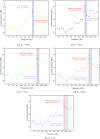Research on Noise-Induced Characteristics of Unsteady Cavitation of a Jet Pump
- PMID: 35449934
- PMCID: PMC9016847
- DOI: 10.1021/acsomega.2c00684
Research on Noise-Induced Characteristics of Unsteady Cavitation of a Jet Pump
Abstract
The dynamic cavitation characteristics of normal-temperature water flowing through a transparent jet pump under different cavitation conditions were experimentally studied by adjusting the pressure ratio. The common results are presented at different pressure ratios, including the temporal and spatial changes of the pressure and noise, together with the visual observation of the cavitation unsteady behaviors using a high-speed camera. The analyses on the measured data and images reveal that the cavitation cloud is generated by periodic oscillations of the jet traveling pressure wave and the bubble traveling pressure wave. The oscillation of the two kinds of interface waves is caused by the collapse of the bubbles, which is the main mechanism of the bubble cloud shedding. As the pressure ratio increases, the maximum length of the jet cloud and bubble cloud linearly decreases, while their oscillation frequency increases gradually. Combined with the cavitation-cloud visualization data and noise frequency analysis, it is proposed that the strong impact between the jet traveling pressure wave and the bubble traveling pressure wave is the main cause of noise. Specially, the acoustic pressure reaches the maximum when the oscillation frequency of the jet traveling pressure wave is the same as that of the bubble traveling pressure wave. Also, the jet traveling pressure wave has a great influence on the migration of bubbles in the cavity. The results can provide guidance for the optimal operating condition in cavitation applications such as jet aerator and quantitative addition.
© 2022 The Authors. Published by American Chemical Society.
Conflict of interest statement
The authors declare no competing financial interest.
Figures














Similar articles
-
Jet and Shock Wave from Collapse of Two Cavitation Bubbles.Sci Rep. 2019 Feb 4;9(1):1352. doi: 10.1038/s41598-018-37868-x. Sci Rep. 2019. PMID: 30718594 Free PMC article.
-
Experimental study of the cavitation noise and vibration induced by the choked flow in a Venturi reactor.Ultrason Sonochem. 2020 Oct;67:105183. doi: 10.1016/j.ultsonch.2020.105183. Epub 2020 May 21. Ultrason Sonochem. 2020. PMID: 32474184
-
Jet formation and shock wave emission during collapse of ultrasound-induced cavitation bubbles and their role in the therapeutic applications of high-intensity focused ultrasound.Phys Med Biol. 2005 Oct 21;50(20):4797-809. doi: 10.1088/0031-9155/50/20/004. Epub 2005 Sep 27. Phys Med Biol. 2005. PMID: 16204873
-
Bubbles with shock waves and ultrasound: a review.Interface Focus. 2015 Oct 6;5(5):20150019. doi: 10.1098/rsfs.2015.0019. Interface Focus. 2015. PMID: 26442143 Free PMC article. Review.
-
In-situ synchrotron X-ray imaging of ultrasound (US)-generated bubbles: Influence of US frequency on microbubble cavitation for membrane fouling remediation.Ultrason Sonochem. 2021 Sep;77:105697. doi: 10.1016/j.ultsonch.2021.105697. Epub 2021 Aug 5. Ultrason Sonochem. 2021. PMID: 34388491 Free PMC article. Review.
Cited by
-
Investigations on cavitation flow and vorticity transport in a jet pump cavitation reactor with variable area ratios.Ultrason Sonochem. 2024 Aug;108:106964. doi: 10.1016/j.ultsonch.2024.106964. Epub 2024 Jun 22. Ultrason Sonochem. 2024. PMID: 38943849 Free PMC article.
References
-
- Haosheng C.; Jiang L.; Darong C.; Jiadao W. Damages on steel surface at the incubation stage of the vibration cavitation erosion in water. Wear 2008, 265, 692–698. 10.1016/j.wear.2007.12.011. - DOI
-
- Dular M. Hydrodynamic cavitation damage in water at elevated temperatures. Wear 2016, 346–347, 78–86. 10.1016/j.wear.2015.11.007. - DOI
-
- Hutli E.; Nedeljkovic M. S.; Radovic N. A.; Bonyár A. The relation between the high speed submerged cavitating jet behaviour and the cavitation erosion process. Int. J. Multiphase Flow 2016, 83, 27–38. 10.1016/j.ijmultiphaseflow.2016.03.005. - DOI
-
- Pathania S.; Ho Q. T.; Hogan S. A.; McCarthy N.; Tobin J. T. Applications of hydrodynamic cavitation for instant rehydration of high protein milk powders. J. Food Eng. 2018, 225, 18–25. 10.1016/j.jfoodeng.2018.01.005. - DOI
LinkOut - more resources
Full Text Sources
Research Materials

